An Improved Zero Potential Circuit for Readout of a Two-Dimensional Resistive Sensor Array
Abstract
:1. Introduction
2. Design and Principle Analysis of the Improved Zero Potential Circuit
3. Experiments and Discussion
3.1. Simulation Experiments
3.1.1. Effect of the Multiplexers’ Switch-on Resistance
3.1.2. Array Size Effect Experiment
3.1.3. Effect of the Resistances of the Non-Scanned Elements
3.1.4. Effects of Array Size, the Non-Scanned Element, and the Multiplexer’ Switch-On Resistance on the Currents
3.2. Test Experiments with the Prototype Circuit
4. Discussion
5. Conclusions
Acknowledgments
Author Contributions
Conflicts of Interest
References
- Pan, L.; Chortos, A.; Yu, G.; Wang, Y.; Isaacson, S.; Allen, R.; Bao, Z. An ultra-sensitive resistive pressure sensor based on hollow-sphere microstructure induced elasticity in conducting polymer film. Nat. Commun. 2014, 5, 1–8. [Google Scholar] [CrossRef] [PubMed]
- Cheng, M.Y.; Tsao, C.M.; Lai, Y.Z.; Yang, Y.J. The development of a highly twistable tactile sensing array with stretchable helical electrodes. Sens. Actuators A Phys. 2011, 166, 226–233. [Google Scholar] [CrossRef]
- Yang, Y.-J.; Cheng, M.-Y.; Shih, S.-C.; Huang, X.-H.; Tsao, C.-M.; Chang, F.-Y.; Fan, K.-C. A 32 × 32 temperature and tactile sensing array using PI-copper films. Int. J. Adv. Manuf. Technol. 2010, 46, 945–956. [Google Scholar] [CrossRef]
- Beccherelli, R.; Zampetti, E.; Pantalei, S.; Bernabei, M.; Persaud, K.C. Design of a very large chemical sensor system for mimicking biological olfaction. Sens. Actuators B Chem. 2010, 146, 446–452. [Google Scholar] [CrossRef]
- Tanaka, A.; Matsumoto, S.; Tsukamoto, N.; Itoh, S.; Chiba, K.; Endoh, T.; Nakazato, A.; Okuyama, K.; Kumazawa, Y.; Hijikawa, M.; et al. Infrared focal plane array incorporating silicon IC process compatible bolometer. IEEE Trans. Electron Devices 1996, 43, 1844–1850. [Google Scholar] [CrossRef]
- Wu, J.F.; Wang, L.; Li, J.Q. A handwriting input method based on the thermal cue of the fingertip. Measurement 2016, 16, 3084–3090. [Google Scholar] [CrossRef]
- Tung, S.T.; Yao, Y.; Glisic, B. Sensing sheet: The sensitivity of thin-film full-bridge strain sensors for crack detection and characterization. Meas. Sci. Technol. 2014, 25, 075602. [Google Scholar] [CrossRef]
- Snyder, W.E.; Clair, J.S. Conductive elastomers as sensor for industrial parts handling equipment. IEEE Trans. Instrum. Meas. 1978, 27, 94–99. [Google Scholar] [CrossRef]
- Prutchi, D.; Arcan, M. Dynamic contact stress analysis using a compliant sensor array. Measurement 1993, 11, 197–210. [Google Scholar] [CrossRef]
- Takei, K.; Takahashi, T.; Ho, J.C.; Ko, H.; Gillies, A.G.; Leu, P.W.; Fearing, R.S.; Javey, A. Nanowire active-matrix circuitry for low-voltage macroscale artificial skin. Nat. Mater. 2010, 9, 821–826. [Google Scholar] [CrossRef] [PubMed]
- Vidal-Verdu, F.; Oballe-Peinado, O.; Sanchez-Duran, J.A. Three Realizations and Comparison of Hardware for Piezoresistive Tactile Sensors. Sensors 2011, 11, 3249–3266. [Google Scholar] [CrossRef] [PubMed]
- Oballe-Peinado, O.; Vidal-Verdu, F.; Sanchez-Duran, J.A.; Castellanos-Ramos, J.; Hidalgo-Lopez, J.A. Improved Circuits with Capacitive Feedback for Readout Resistive Sensor Arrays. Sensors 2016, 16, 149. [Google Scholar] [CrossRef] [PubMed]
- Tise, B. A compact high resolution piezoresistive digital tactile sensor. In Proceedings of the 1988 IEEE International Conference on Robotics and Automation, New York, NY, USA, 24–29 April 1988; pp. 760–764.
- Speeter, T.H. A tactile sensing system for robotic manipulation. Int. J. Robot. Res. 1990, 9, 25–36. [Google Scholar] [CrossRef]
- Wu, J.F.; Wang, L.; Li, J.Q. Design and crosstalk error analysis of the circuit for the 2-D networked resistive sensor array. IEEE Sens. J. 2015, 15, 1020–1026. [Google Scholar] [CrossRef]
- Wu, J.F.; Wang, L.; Li, J.Q.; Song, A.G. A novel crosstalk suppression method of the 2-D networked resistive sensor array. Sensors 2014, 14, 12816–12827. [Google Scholar] [CrossRef] [PubMed]
- Liu, H.; Zhang, Y.-F.; Liu, Y.-W.; Jin, M.-H. Measurement errors in the scanning of resistive sensor arrays. Sens. Actuators A Phys. 2010, 163, 198–204. [Google Scholar] [CrossRef]
- Lazzarini, R.; Magni, R.; Dario, P. A tactile array sensor layered in an artificial skin. In Proceedings of the 1995 IEEE/RSJ International Conference on Intelligent Robots and Systems 95.’Human Robot Interaction and Cooperative Robots, Pittsburgh, PA, USA, 5–9 August 1995; pp. 114–119.
- Saxena, R.S.; Saini, N.K.; Bhan, R.K.; Muralidharan, R. Virtual Ground Technique for Crosstalk Suppression in Networked Resistive Sensors. IEEE Sens. J. 2011, 11, 432–433. [Google Scholar] [CrossRef]
- Yarahmadi, R.; Safarpour, A.; Lotfi, R. An improved-accuracy approach for readout of large-array resistive sensors. IEEE Sens. J. 2016, 16, 210–215. [Google Scholar] [CrossRef]
- Saxena, R.S.; Bhan, R.K.; Aggrawal, A. A new discrete circuit for readout of resistive sensor arrays. Sens. Actuators A Phys. 2009, 149, 93–99. [Google Scholar] [CrossRef]
- Wu, J.F.; He, S.S.; Li, J.Q.; Song, A.G. Cable Crosstalk Suppression with Two-Wire Voltage Feedback Method for Resistive Sensor Array. Sensors 2016, 16, 253. [Google Scholar] [CrossRef] [PubMed]
- Wu, J.F.; Wang, L. Cable Crosstalk Suppression in Resistive Sensor Array with 2-Wire S-NSDE-EP Method. J. Sens. 2016, 2016, 1–9. [Google Scholar] [CrossRef]
- Kim, J.S.; Kwon, D.Y.; Choi, B.D. High-Accuracy, Compact Scanning Method and Circuit for Resistive Sensor Arrays. Sensors 2016, 16, 155. [Google Scholar] [CrossRef] [PubMed]
- Wu, J.; Wang, Y.; Li, J.; Song, A. A Novel Two-Wire Fast Readout Approach for Suppressing Cable Crosstalk in a Tactile Resistive Sensor Array. Sensors 2016, 16, 720. [Google Scholar] [CrossRef] [PubMed]
- Wu, J.; Li, J. Approximate model of zero potential circuits for the 2-D networked resistive sensor array. IEEE Sens. J. 2016, 16, 3084–3090. [Google Scholar] [CrossRef]
- ThruMode Matrix Array. Available online: http://sensitronics.com/product-res/thru-mode-matrix-array/docs/Thru-Mode-Matrix-Array-Response.pdf (accessed on 14 October 2016).
- ShuntMode Matrix Array. Available online: http://sensitronics.com/product-res/shunt-mode-matrix-array/docs/Shunt-Mode-Matrix-Array-Response.pdf (accessed on 14 October 2016).
- Conso, F.; Grassi, M.; Malcovati, P.; Baschirotto, A. A very high dynamic range interface circuit for resistive gas sensor matrix read-out. In Proceedings of the IEEE Circuits System (ISCAS), Rio de Janeiro, Brazil, 15–18 May 2011; pp. 2209–2212.
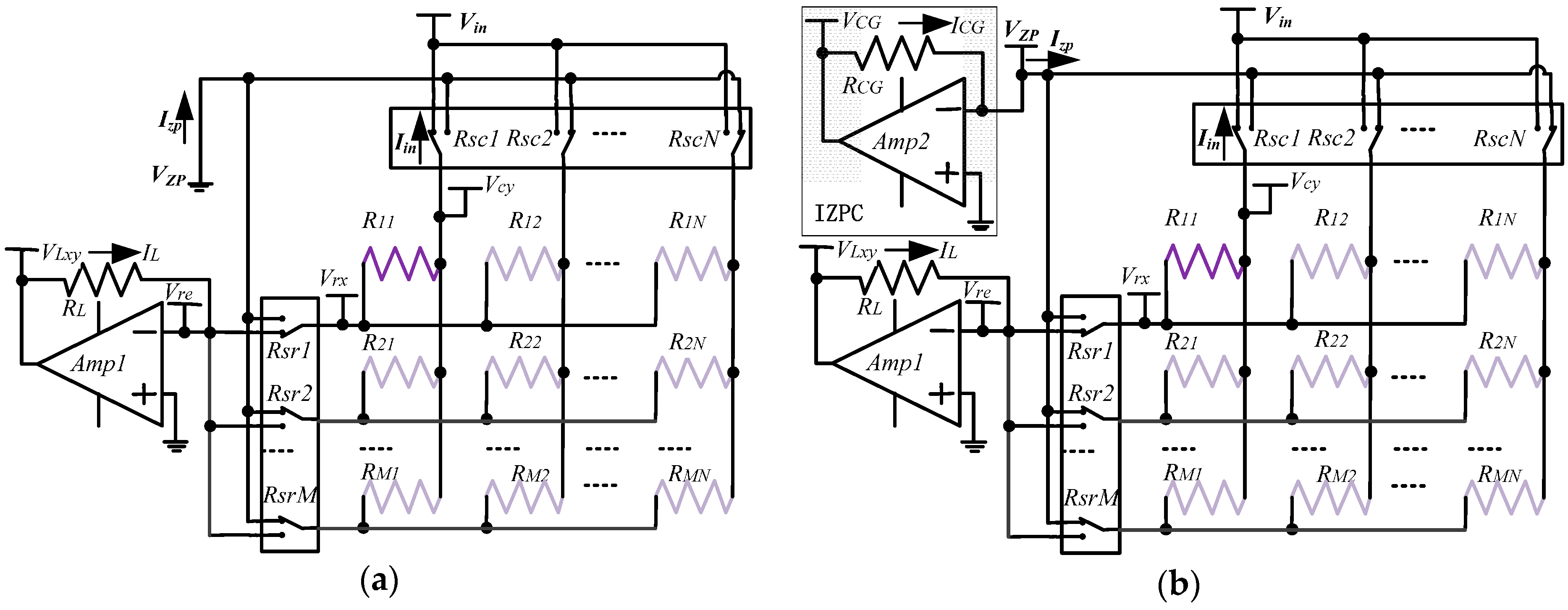
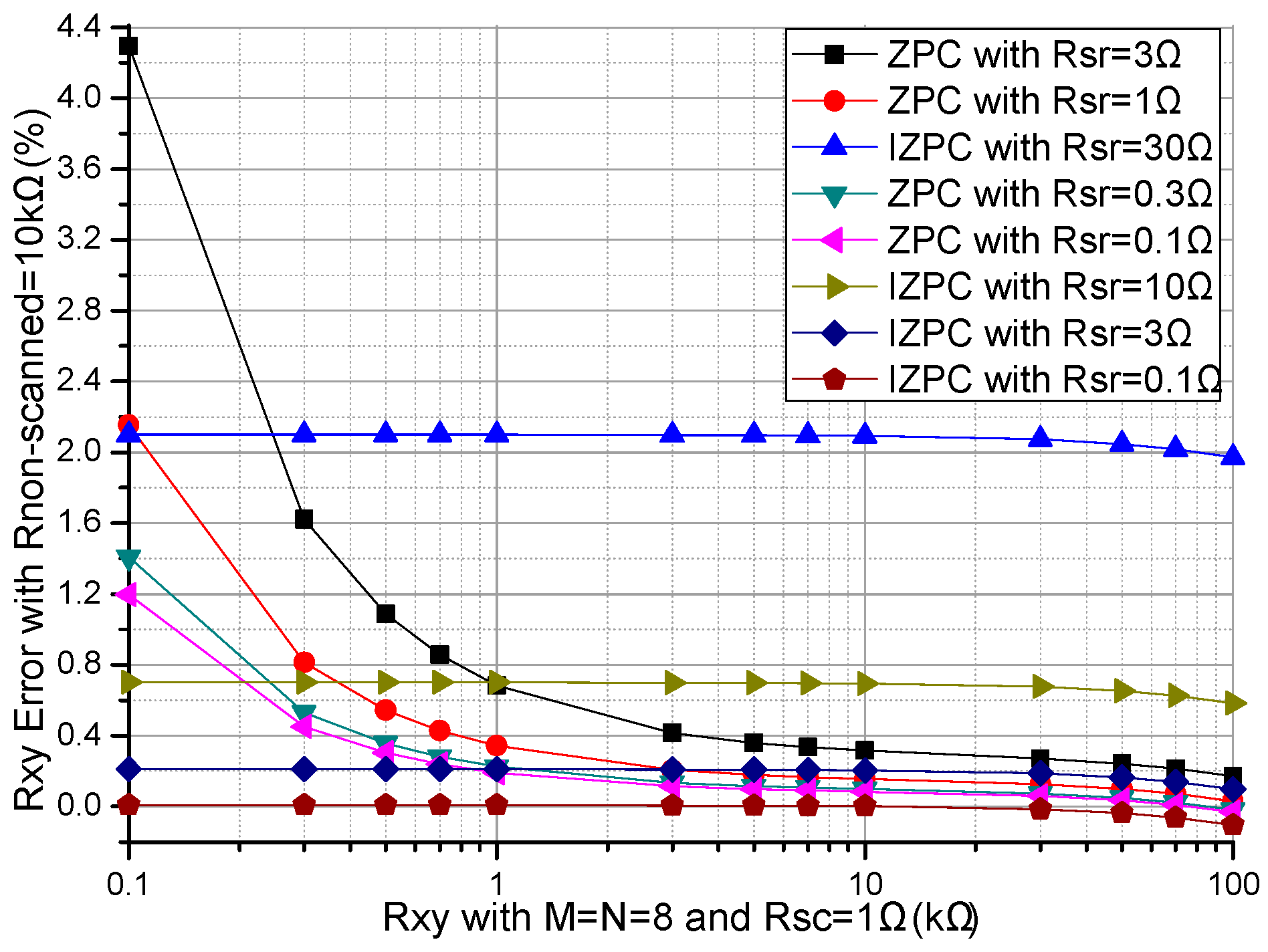
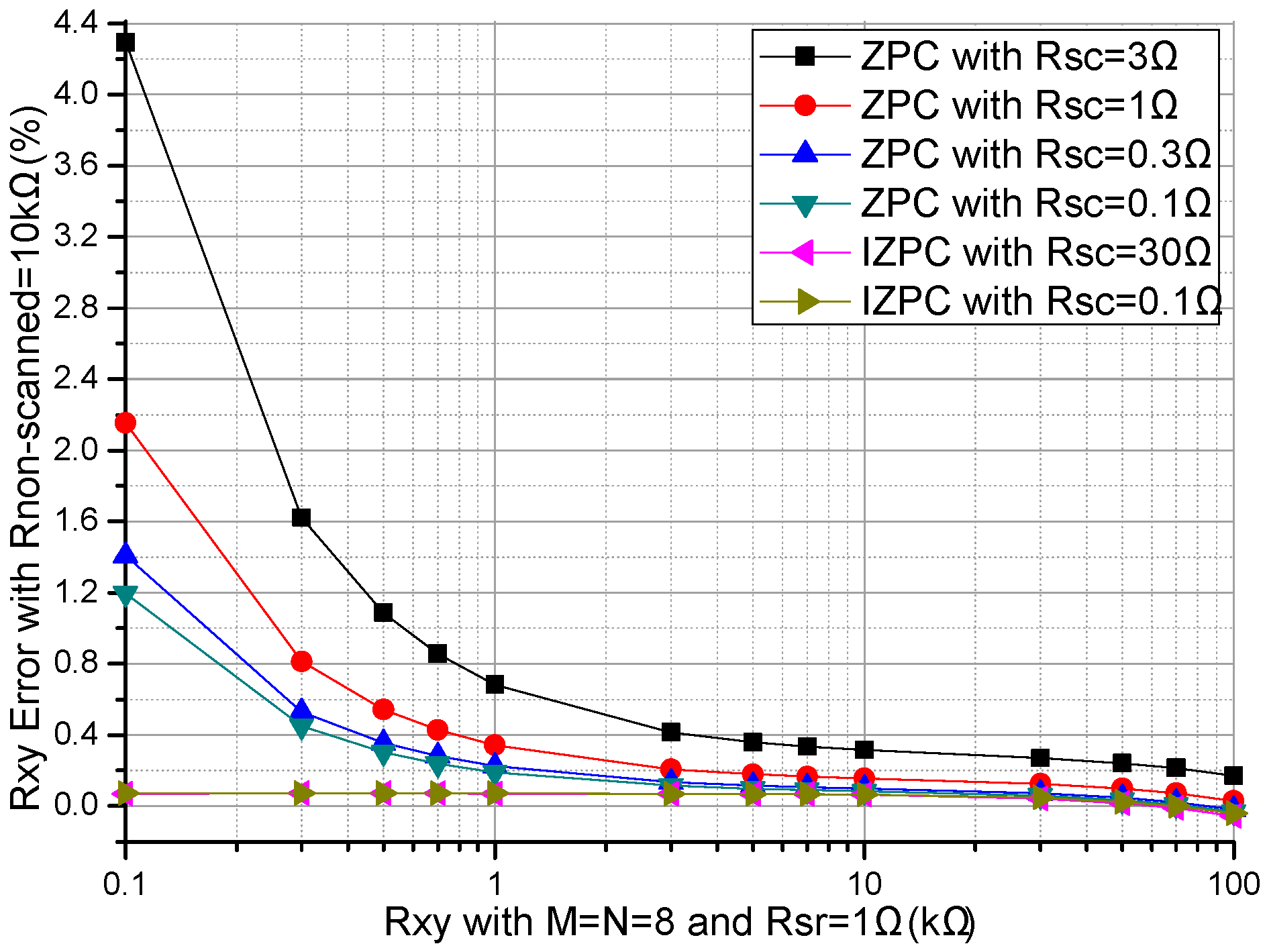
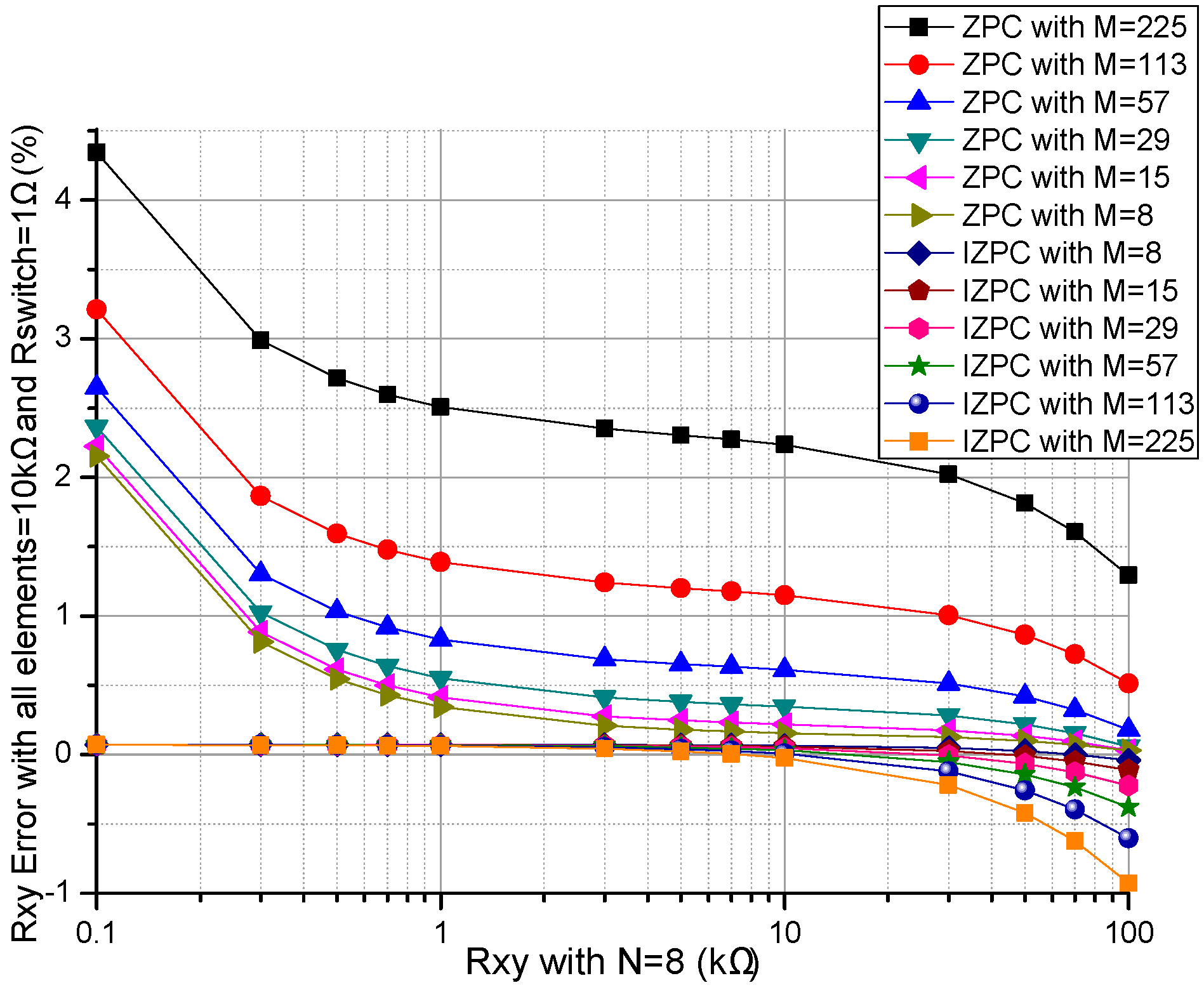

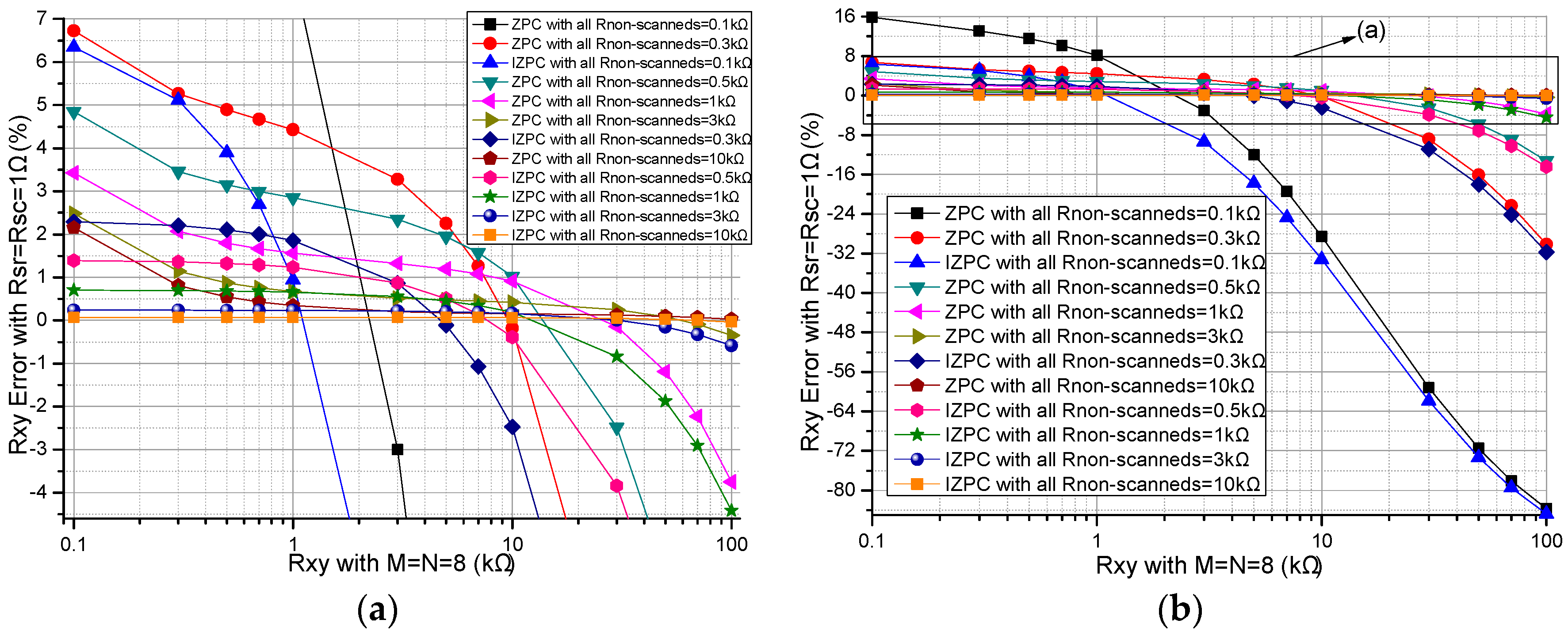
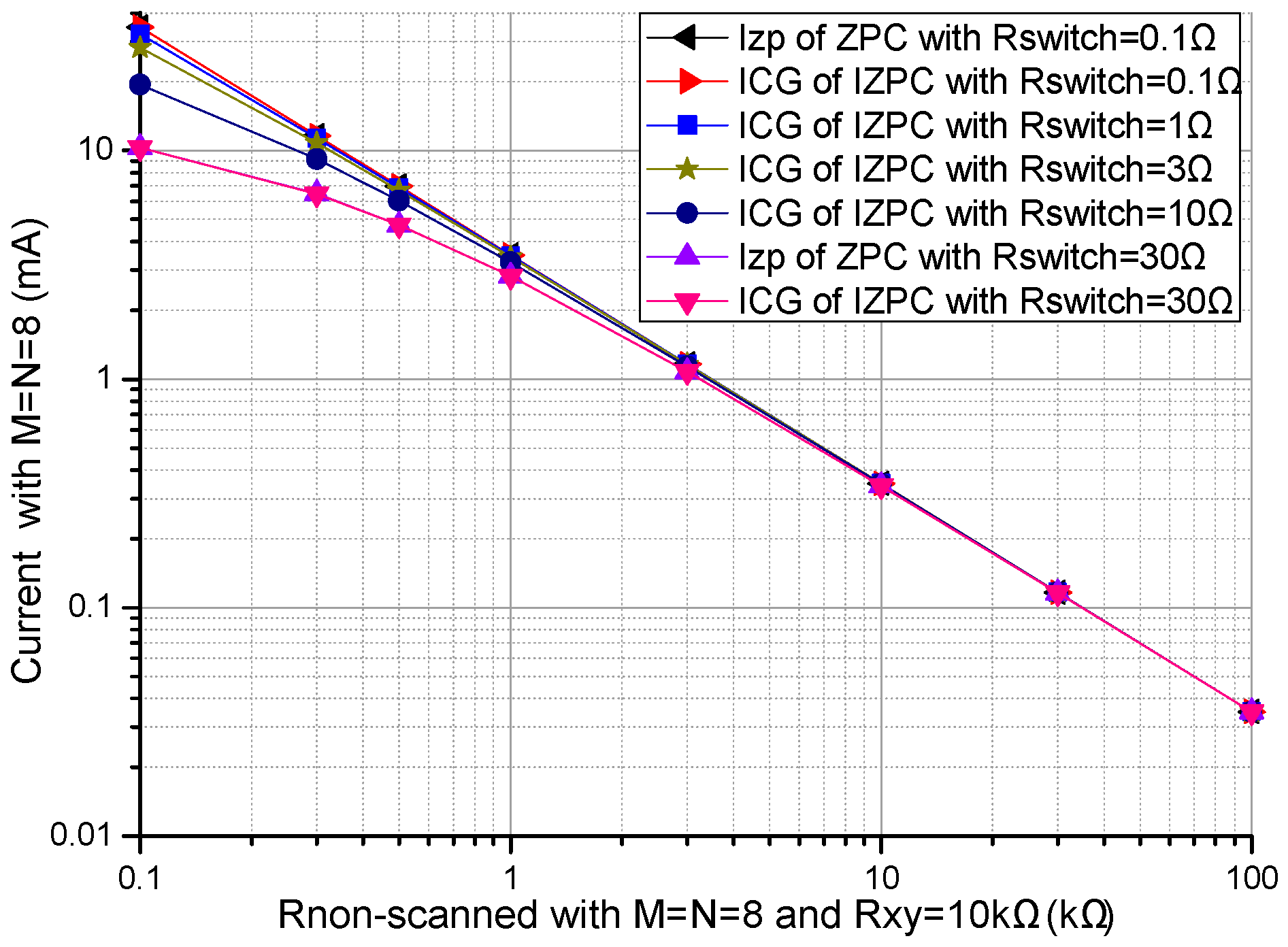
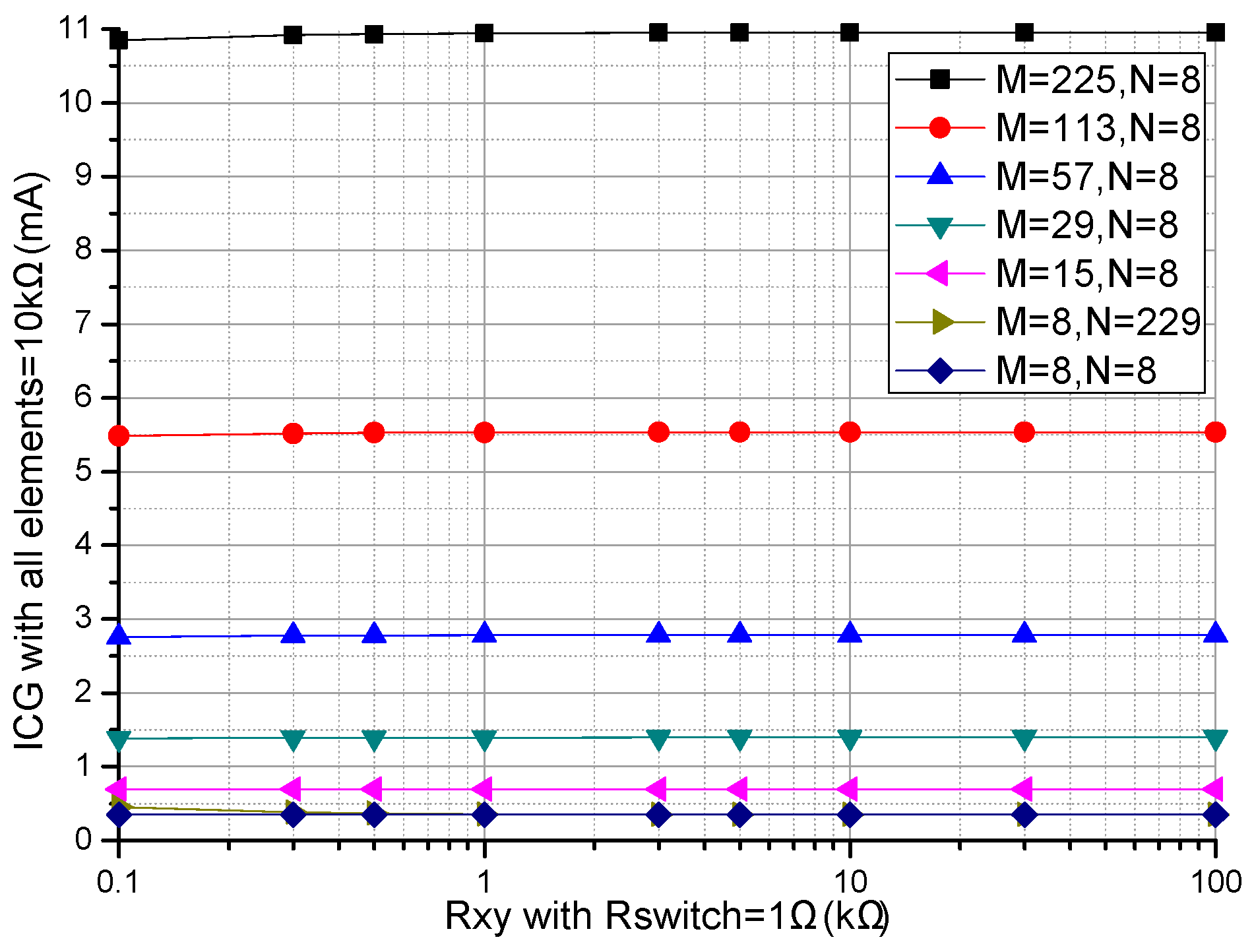
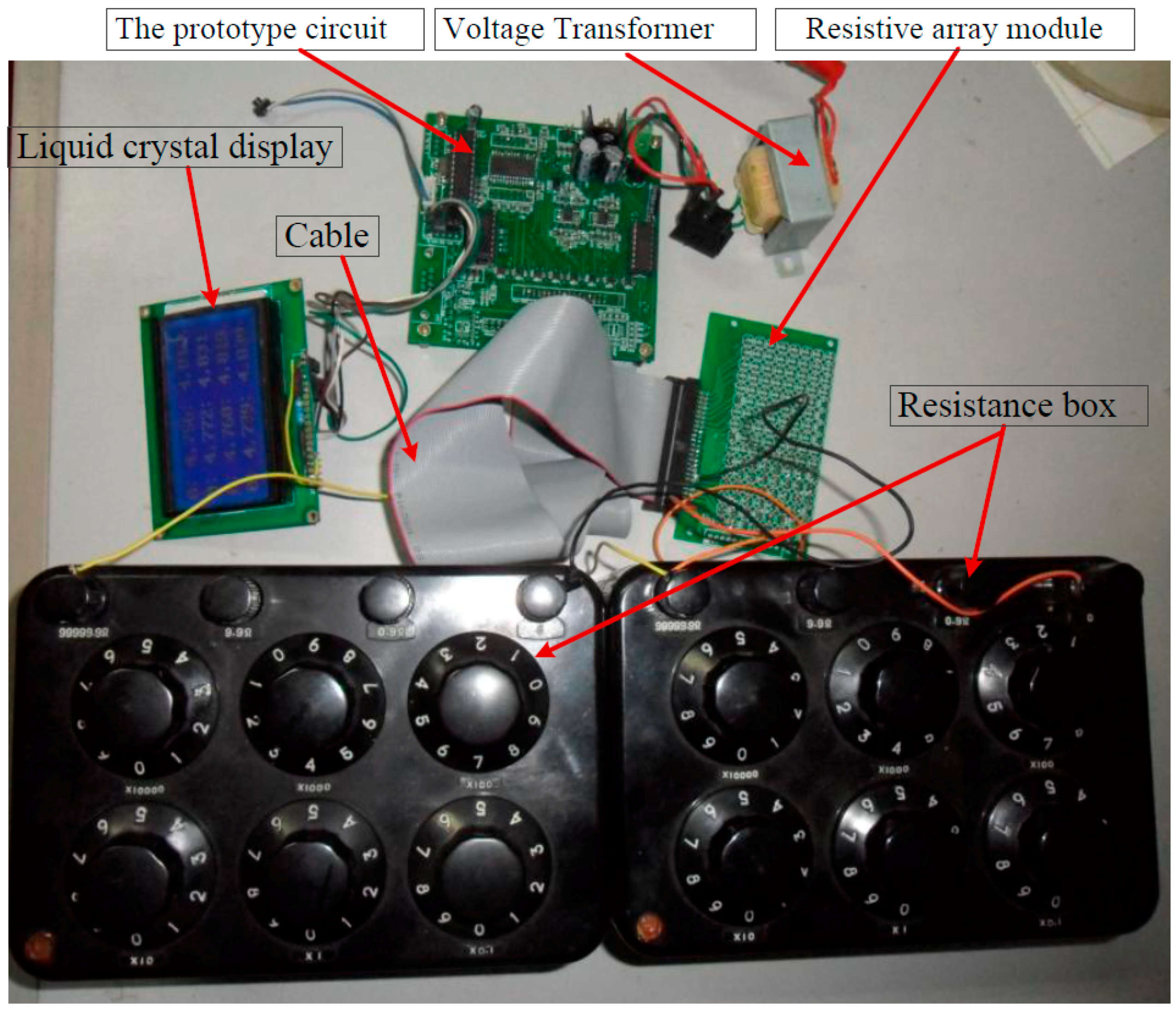

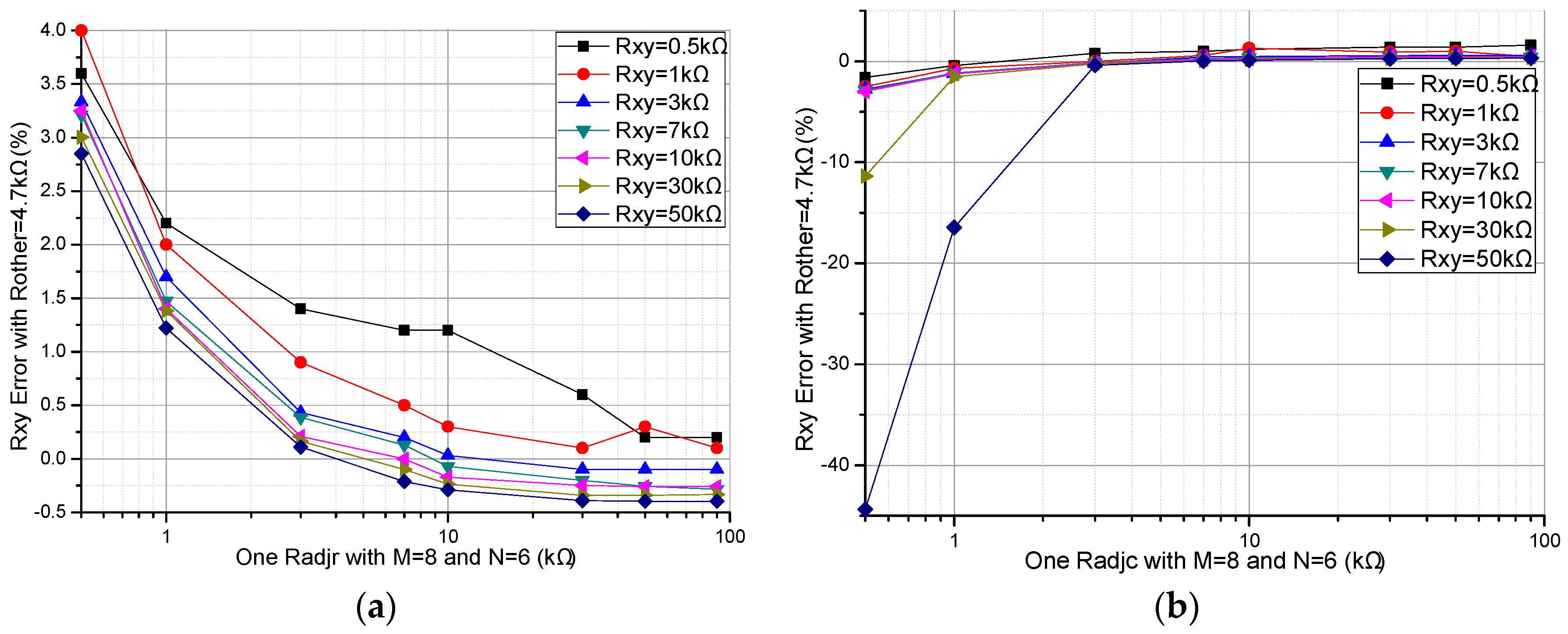
| Methods | Auxiliary Components | Advantages | Disadvantages |
|---|---|---|---|
| Basic ZPC [17] | M + N multiplexers, one op-amp, one resistor, and one sampling channel | Simplest structure | Rswitchs’ crosstalk, Low readout rate |
| IIDFC [15] | M + N multiplexers, one op-amp, three resistors, and one sampling channel | Simpler structure, Rswitchs’ crosstalk partly suppressed | Part Rswitchs’ crosstalk, Low readout rate |
| IIDFC with Compensation [16] | M + N multiplexers, one op-amp, four resistors, and two sampling channels | Rswitchs’ crosstalk suppressed, and simple structure, | Low readout rate |
| Two-wire VFC [22] | 2M + N multiplexers, N + 1 op-amps, one resistor, and two sampling channels | Cable’s crosstalk suppressed, Rswitchs’ crosstalk suppressed, | Complex structure, Low readout rate |
| Two-wire ZPC [23] | 2M + N multiplexers, M + N op-amps, three resistors, and two sampling channels | Cable’s crosstalk suppressed, Rswitchs’ crosstalk suppressed, | Complex structure, Low readout rate |
| Multi-channel part Two-wire ZPC [24] | M multiplexers, N + 1 op-amps, N resistors, and N sampling channels | Better accuracy, and fastest readout rate | More complex structure |
| Multi-channel full 2-wire ZPC [25] | N multiplexers, M op-amps, M resistors, and M sampling channels | Best accuracy, and fastest readout rate | Most complex structure |
| Proposed | M + N multiplexers, two resistors, and two sampling channels | Rswitchs’ crosstalk suppressed, simple structure, and estimation of array’s power | Low readout rate |
© 2016 by the authors; licensee MDPI, Basel, Switzerland. This article is an open access article distributed under the terms and conditions of the Creative Commons Attribution (CC-BY) license (http://creativecommons.org/licenses/by/4.0/).
Share and Cite
Wu, J.-F.; Wang, F.; Wang, Q.; Li, J.-Q.; Song, A.-G. An Improved Zero Potential Circuit for Readout of a Two-Dimensional Resistive Sensor Array. Sensors 2016, 16, 2070. https://doi.org/10.3390/s16122070
Wu J-F, Wang F, Wang Q, Li J-Q, Song A-G. An Improved Zero Potential Circuit for Readout of a Two-Dimensional Resistive Sensor Array. Sensors. 2016; 16(12):2070. https://doi.org/10.3390/s16122070
Chicago/Turabian StyleWu, Jian-Feng, Feng Wang, Qi Wang, Jian-Qing Li, and Ai-Guo Song. 2016. "An Improved Zero Potential Circuit for Readout of a Two-Dimensional Resistive Sensor Array" Sensors 16, no. 12: 2070. https://doi.org/10.3390/s16122070






